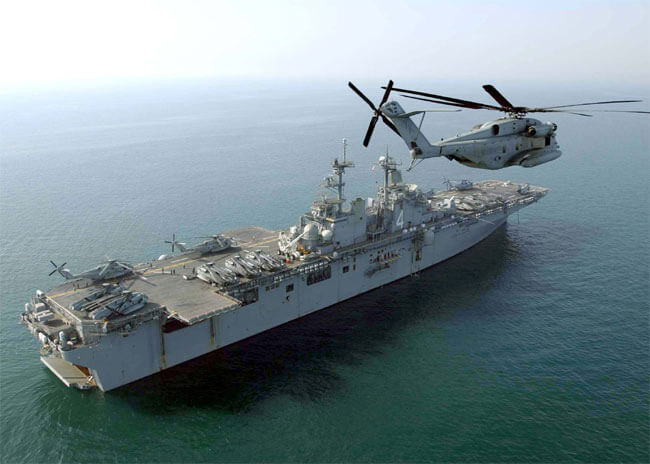While it was about to transit through the Strait of Hormuz, the amphibious assault ship USS Boxer shot down an approaching Iranian drone, the Pentagon reported. However, Iran authorities denied losing any of their drones.
U.S. President Donald Trump announced that “[USS] Boxer took defensive action against an Iranian drone, which had closed into a very, very near distance, approximately 1,000 yards, ignoring multiple calls to stand down and was threatening the safety of the ship and the ship’s crew”. He qualified it as “the latest of many provocative and hostile actions by Iran against vessels operating in international waters”, and one of “Iran’s attempts to disrupt freedom of navigation and global commerce”.
The information was confirmed later by the Pentagon, which states that a “fixed wing unmanned aerial system (UAS)” approached the ship as it was “conducting a planned inbound transit of the Strait of Hormuz”.
Several other incidents during the transit were reported by the Wall Street Journal. An unarmed Iranian Navy Bell 212 helicopter approached the USS Boxer before being chased by an MH-60R Seahawk aircraft. Then multiple Iranian fast boats were spotted. Eventually, an unidentified Iranian ship reportedly sailed near the USS Boxer, before the incident involving the drone.
In this photo released by the Pentagon, a MH-60R Sea Hawk helicopter flies next to an #Iran|ian helicopter while the USS Boxer makes its way through the Strait of #Hormuz, per defense officials pic.twitter.com/Oou2QGDqGc
— Jeff Seldin (@jseldin) July 18, 2019
The Iranian authorities deny that any of their drones were shot down. “Contrary to the false claim rooted in Trump’s illusions, all Unmanned Aerial Vehicles (UAVs) of the Islamic Republic of Iran in the Persian Gulf and the Strait of Hormuz […], have returned safely to their bases after completing their scheduled reconnaissance and patrol missions,” declared Abolfazl Shekarchi, a senior spokesman for the General Staff of the Iranian Armed Forces quoted by Tasnim News Agency. Deputy Foreign Minister of Iran Abbas Araghchi even suggested that the US Navy may have destroyed one of their own drones.
We have not lost any drone in the Strait of Hormuz nor anywhere else. I am worried that USS Boxer has shot down their own UAS by mistake!
— Seyed Abbas Araghchi (@araghchi) July 19, 2019
A month ago, on June 20, 2019, a U.S. Navy RQ-4 Global Hawk surveillance drone was shot down by an anti-air missile of the Iranian Revolutionary Guards Corps (IRCG), as the drone was flying near the coast of Iran. Following the incident, several airlines modified their routes or suspended flights that crossed the airspace above the Strait of Hormuz and the Gulf of Oman.
It is not the first time that an Iranian drone approaches a ship from the U.S. Navy. In April 2019, shortly after leaders of Iran and the United States classified each other’s armed forces as “terrorist organizations”, the IRGC naval forces released footage filmed from an Ababil III UAV of the USS Dwight D. Eisenhower carrier. The video dated back to 2016.
A high definition footage obtained by #IRGC naval forces shows the #US warships being closely monitored in the #PersianGulf waters, south of #Iranhttps://t.co/BEaY2NhbIL pic.twitter.com/k8Pzh8wdGO
— Tasnim News Agency (@Tasnimnews_EN) April 27, 2019
In 2018, the United States withdrew from the Joint Comprehensive Plan of Action (JCPoA), an agreement on the Iranian nuclear program that also involved Germany, China, France, the United Kingdom, and Russia. Since then, tensions have escalated between the United States and Iran.
An open conflict could weigh a heavy cost on the global economy. As the United States decided to reestablish economic sanctions on Iran, both Boeing and Airbus had to suspend multi-billion ongoing contracts with several Iranian airlines. Moreover, a fifth of the world’s oil passes each day through the Strait of Hormuz, whose safety is now compromised.
